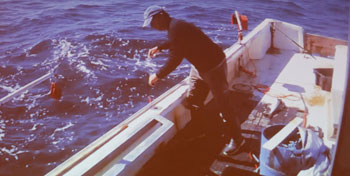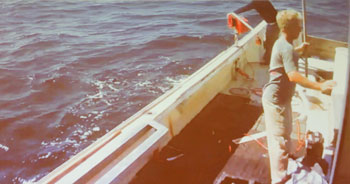Electronic Monitoring Over Observers
at Forum

Funding for equipping vessels with electronic monitoring gear for the pilot program came from the National Fish and Wildlife Association.

The video enables the captain to view the four deck areas from the wheelhouse. Video monitors what fish are coming aboard and crew safety. Photos courtesy of EM Pilot Program
ROCKPORT — Four groundfish captains reported the results of their experimental use of electronic monitoring equipment in a pilot program. The Maine Fishermen’s Forum featured the meeting, which included National Marine Fisheries Service representatives and fishermen in the audience. Regulations, requiring a percentage of groundfish vessels to take observers out with them and pay about $700 a day to have them aboard and pay their expenses, have not gone over well with fishermen.
The four panelists said that having cameras aboard was intrusive. But all agreed it was better than having a stranger onboard who was looking for something to be wrong. The captain was burdened with being responsible for the safety of observers while they were on his boat. Observers were not always available for a narrow window weather opportunity to fish.
Bob Dooley, a commercial fisherman from Half Moon Bay, Calif., said having observers onboard could offer opportunities to catch fish that otherwise would not be available. Dooley said that, following changes in the West Coast groundfishery in the late 1980s, some boats had 100% observers that they paid for and still made a profit. But after 2000 the cost of onboard observers became too burdensome. “Electronic monitoring is the answer to that expense,” said Dooley.
Mike Russo fishes out of Provincetown, MA. Russo said improvements were needed to scientific data collection, but he added that the evidence of what fishermen were seeing also needed to be considered in order to reduce the uncertainty of divergent opinions. “The information from electronic monitoring reduces that uncertainty,” said Russo.
Tyler Bond said he didn’t want observers aboard for safety reasons. He said science was saying there are no cod and he wanted to prove them wrong, so he went to 100% electronic monitoring coverage. He fished gill nets. “The system is easy to use and flexible,” he said.
Randy Cushman of Port Clyde said that one thing electronic monitoring has done for him is less discards. “I’ve increased the mesh size to improve that,” he said.
The fishermen were asked if they had to change the way they fish while using the video cameras. Russo said, “Yes, there were some changes. But it made me more efficient. I don’t have catch handling problems now.” The cameras are set up to observe discard areas, “and they see everything,” he said. “It can take a while to get them set up right for any particular boat in order to see all that’s going on.”
According to speakers, the video is checked against the sorting information that fishermen enter into the recording system. That information is used in the stock assessment process.
Russo said that, at first, he spent 3 hours sorting catch and entering the data into the system, but he’s down to one hour now.
In New England most of the funding for equipping fishing boats in the pilot program with electronic monitoring technology came from the National Fish and Wildlife Association. A small part of the funding came from the federal observers program. That funding was used to review the video taken on the boats. Electronic monitoring is estimated to cost half as much as on board observers. The cost of electronic monitoring is expected to go down, while the introduction of new metrics and technology is expected to deliver more information.
